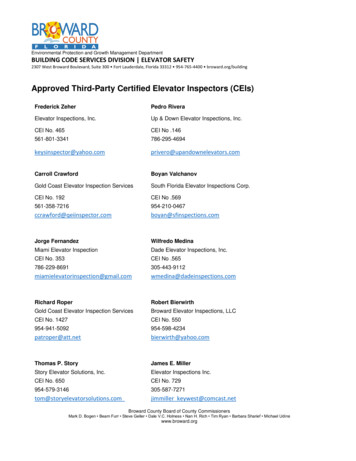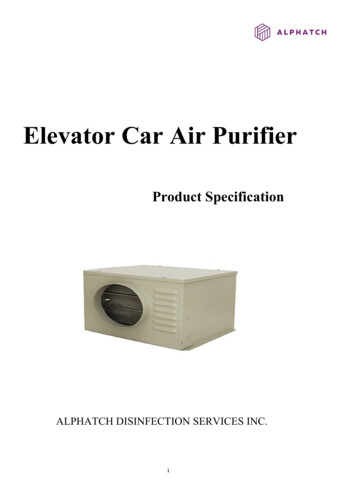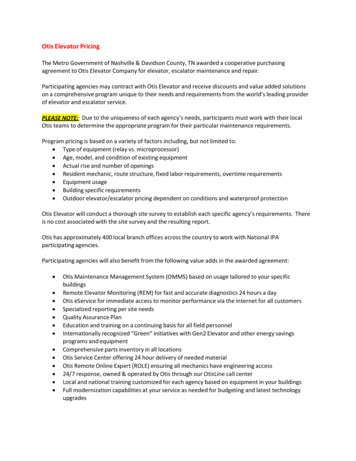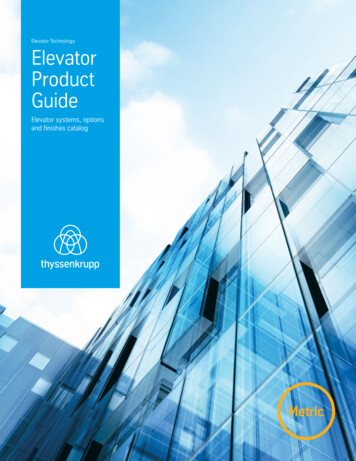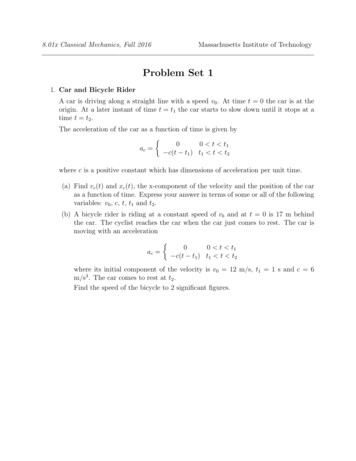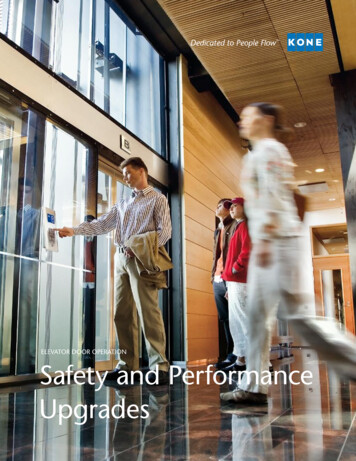
Transcription
Elevator 101Introduction to ElevatorTechnology
AcknowledgementsWe wish to thank Otis Elevators, AUnited Technologies Company, formaterials used in this tutorial.
Traction System Elevator pulled above bywire hoist ropesOperating machinerypositioned aboveelevator hoistwayModerate to high speedMedium and high-rise
Elevator Pits Safe and convenientaccess shall beprovided to all pits.Pits shall be accessibleonly to authorizedpersonsA permanent lightingfixture shall beprovided in all pits andthe bulb shall beguarded
Elevator OperatingEquipment
Door ProtectionElevators are protected by a several types of door reopeningdevices: Infrared Safety Curtains – These devices scan the areasadjacent to the elevator door(s) and automatically reopenthe door(s) when the presence of an object is detected. Thisis the most modern means of door protection.Electronic Photo-eyes – These devices send out two (2) ormore fixed beams that cause reopening when someone orsomething breaks the beam. These are used in conjunctionwith mechanical safety edges.Mechanical Edges – These devices must make physicalcontact with a person or object to trigger reopening.
Door SafetyIf someone is moving towards the elevator,utilize the door open button on the carcontrol panel to wait for them. The doorreopening devices are designed to turn offduring the last 2 to 4 inches of traveltherefore someone should never stick anobject or limb in the path of a closing door.
Elevator Leveling Elevators are required to stop at each floorwithin plus or minus ½” of the floor landing.A simple method of assessing that yourelevator is approaching the maximum ½”tolerance allowed by code is to draw the soleof your shoe across the landing sill.Caution should be advised to anyonewearing bi-focal glasses.
Emergency Communication Most elevators have an Alarm Bell andTelephone or Intercom. It is also important to have a functioningemergency light in the elevator to avoidleaving a trapped passenger in the dark asthey wait for assistance.
New Elevator Technology MachineRoom Less Elevators Coated Steel Elevator Belts Gearless Machines
Gearless machineCompact and efficient AC gearless machine tucks away atthe top of the hoistway – 70 %smaller Compact synchronous permanentmagnet motor Up to 50% more efficient thanconventional geared machines
GlossaryThe remaining slides in thispresentation contain a glossary ofcommon elevator parts and terms
Glossary of Elevator Terms
Glossary of Elevator Terms Cable (Rope) - Usually 4 to 6 innumber, it is used to support thecar and (passing over the drivesheave to the counterweight) pullthe car. Car Counterweight - A set ofweights roped directly to theelevator car of a winding-drumtype installation. In practice, thisweight is equal to approximately 70percent of the car weight. Car Operating Panel/Station - Apanel mounted in the carcontaining the car operatingcontrols, such as call registerbuttons, door open and close,alarm, emergency stop andwhatever other buttons or keyswitches are required for operating.
Glossary of Elevator Terms Clutch - A device used in elevatorpower door operation to engagethe car door to the landing door bya grasping and holding movement. Compensating Chain - A weldedlink chain used for hoist ropeweight compensation.One end of the chain is attached tothe underside of the elevator car,and the other end is fastened to thecounterweight or stationaryfastening in the hoistway.
Glossary of Elevator Terms Compounding Sheave - A pulleylocated on the car, and on thecounterweight, under which thehoist cables run to double thecapacity and reduce the speed of anelevator.Counterweight - A weight whichcounterbalances the weight of anelevator car plus approximately40% of the capacity load.Cylinder - The outermost lining ofa hydraulic jack.
Glossary of Elevator Terms Door Gibs - Devices at thebottom of horizontal sliding doorpanels, which stick into sill groovesand eliminate door panels swingingin or out. Door Hanger - A rolling assemblyfastened to the top of a door panelwhich supports and allowshorizontal sliding movement of thedoor panel. The door track onwhich the hanger rolls is part of thedoor hanger assembly.
Glossary of Elevator Terms Door Protective Device - Anytype of device used with automaticpower operated doors that detectsobstructions to the normal closingof the elevator doors and eithercauses the doors to reopen or gointo some other mode ofoperation, such as nudging. A safeedge, a safety astragal, aphotoelectric device (safe ray), andelectrostatic field device areexamples of door protectivedevices.Door Sill - The threshold of adoor opening with grooves toguide the bottom of the car door.
Glossary of Elevator Terms Governor - (1) A mechanical speedcontrol mechanism. For elevator, itis a wire rope driven centrifugaldevice used to stop and hold themovement of its driving rope. Thisinitiates the activation of the carsafety device. It opens a switch,which cuts off power to the drivemotor and brake if the car travelsat a preset overspeed in the downdirection. Some types of governorswill also open the governor switchand cut off power to the drivemotor and brake if the caroverspeeds in the up direction. (2)
Glossary of Elevator Terms Guide Rails - Steel T-, round, orformed sections with guiding surfacesinstalled vertically in a hoistway toguide and direct the course of travel ofan elevator car and elevatorcounterweights.Guide Shoes - (1) Devices usedmainly to guide the car andcounterweight along the path of theguide rails. They also assure that thelateral motion of the car andcounterweight is kept ata minimum as they travel along theguide rails. (2) Guiding projectionsmounted on the bottom edge ofhorizontally sliding doors or gates, oron the sides of vertically sliding doorsor gatesto guide them.
Glossary of Elevator Terms Hoistway - The space enclosed byfireproof walls and elevator doorsfor the travel of one or moreelevators, dumbwaiters or materiallifts. It includes the pit andterminates at the underside of theoverhead machinery space floor orgrating, or at the underside of theroof where the hoistway does notpenetrate the roof. (Hoistway issometimes called "hatchway" or"hatch".)Oil Buffer - One type of buffer(for elevators with speeds of morethan 200 feet per minute), whichuses a combination of oil andspring to cushion the elevator. It islocated in the elevator pit.
Glossary of Elevator Terms Pickup Rollers - Devices on thehoistway door which mate with theclutch on the car door to allow thehoistway doors to be pulled open andclosed.Platform - The entire floor assemblyof an elevator on which passengersstand or the load is carried.Roller Guides - Guide shoes whichuse rollers that rotate on guide railsrather than sliding on the rails.Safety - A large clamp that anchorsthe car to the building to keep theelevator from falling.
Glossary of Elevator Terms Shackle - Threaded rods to whichthe hoist cables are socketed andwhich bolt to the hitch plate andthe counterweight.Sling - The basic structural frame,which consists of two stiles, acrosshead and a bolster or safetyplant, which supports the platformand cab of an elevator.Spring Buffer - One type ofbuffer, for elevators with speedsless then 200 feet per minute,which cushions the elevator. It islocated in the elevator pit.
Glossary of Elevator Terms Strike Column - Column locatedinside the car, which extends thefull height of the elevator dooropening. This is the column againstwhich the sliding door closes. Traveling Cable - A cable madeup of electric conductors, whichprovides electrical connectionbetween an elevator or dumbwaitercar, or material lift, and a fixedoutlet in the hoistway or machineroom.
Glossary of Elevator Terms Door Protective Device - Any type of device used with automatic power operated doors that detects obstructions to the normal closing of the elevator doors and either of the elevator doors and either causes the doors to reopen or go into some other mode of into some other mode of operation, such as nudging. A safe

